|
| |
| |
| |
A Naturally Gifted Painter
The Work of Anthony van Dyck
Our first sight of Anthony van Dyck is in a Self-Portrait which today is in the Academy of Fine Arts in Vienna. Painted when he was about sixteen, it shows a handsome, alert young man. His glance, over his right shoulder, is direct and self-assured. It is painted with a skill and self-confidence which is extraordinary for such a young painter. Such absolute technical assurance is a consistent feature of Van Dyck's work. For him the process of learning to paint, so gradual and so painful for many of even the greatest artists, was effortless. He was a prodigy, a naturally gifted painter.
Anthony van Dyck was born in Antwerp almost 400 years ago, on 22 March 1599. He was the seventh child and second son of a successful silk merchant, Frans van Dyck. The tightly-knit and pious family lived in an imposing house, De Berendans, in the heart of the city. There was nothing in Anthony's father's family background to suggest that the young man would make painting his career. However, his mother, Maria Cuypers, who died when Anthony was only eight years old, was a member of a large family which included a number of painters and one of her relatives, Pauline Cuypers, was married to the painter Jan Snellincx, who was to be included by Van Dyck in his series of portraits of distinguished contemporaries, the Iconography. Many of the painters in the city were related by the intermarriage of the Snellincx, Bruegel, De Jode and De Wael families, all of them dynasties of painters and engravers. It may have been his mother's family connection with this almost incestuous world of Antwerp artists that caused the ten-year-old Anthony van Dyck to be sent as an apprentice in 1609 to Hendrick van Balen, who was Dean of the painters' guild, the Guild of Saint Luke. Van Balen was a successful figure painter in a conservative Italianate tradition. He had lived in Italy and studied the work of Raphael and Michelangelo, returning home to paint mythological figures which were a pale reflection of those by the masters of the Roman High Renaissance. He often collaborated with landscape painters, notably Jan Bruegel the Elder, in mythological and Biblical scenes.
It was in Van Balen's Antwerp studio that the young Van Dyck learnt the basic skills of his craft. As a young apprentice he would have had to grind pigments and prepare oak panels and canvasses with gesso and other prim- | |
| |
ing. He must have eventually progressed from such menial tasks to drawing from casts of antique statuary and from prints after Italian and Low Countries paintings. He would then have graduated to painting the least important areas - drapery, architectural backgrounds, distant landscapes and even subsidiary figures - in pictures taking shape in the studio.
It was the usual practice in Antwerp for apprentices to remain in their masters' studios until they were themselves accepted as masters in the guild. Van Dyck entered the Antwerp Guild of Saint Luke as a master in February 1618, but we know that the precocious young artist had already established himself as an independent painter in 1615 or 1616. Recent research suggests that this may have been because Anthony's father was experiencing financial difficulties at this moment and so it was important that his son became self-supporting. It was during the period between his leaving Van Balen's studio and his official entry into the guild as a master that Van Dyck painted the series of panels showing Christ and the Apostles in bust-length.
The inspiration for this series came not from his teacher Hendrick van Balen but from Peter Paul Rubens, who after his return from Italy in 1608
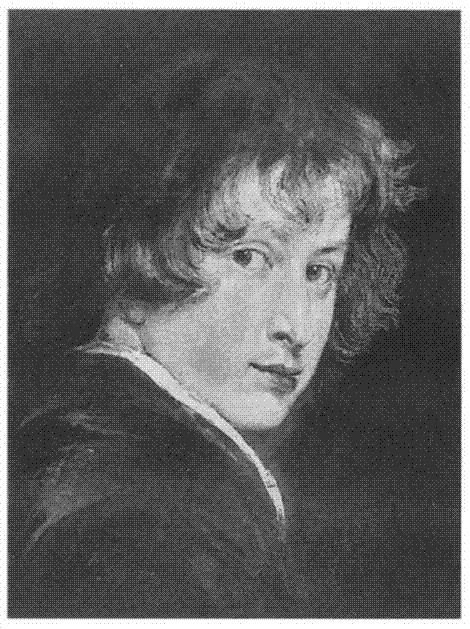
Anthony van Dyck, Self-Portrait. c.1615. Canvas. Akademie der bildenden Künste, Vienna.
had established himself as the leading painter of religious subjects in the city. It was during the years of Van Dyck's apprenticeship that Rubens burst upon the artistic scene in Antwerp with a series of altarpieces of startling originality and power. To the young Van Dyck - and indeed to a whole generation of young Antwerp painters - the Elevation of the Cross triptych painted for the Church of Saint Walburga and the Descent from the Cross painted for the Cathedral announced a new, intensely exciting artistic language. It is hardly surprising, therefore, that Van Dyck moved into the orbit of Rubens. In 1618 Van Dyck was working in Rubens' studio on a series of eight tapestry cartoons telling the story of the life and heroic death of the Roman consul Decius Mus which had been commissioned by a noble Genoese family. This series of cartoons is today in the collection of the Prince of Liechtenstein in Vaduz. Following the successful completion of the Decius Mus cartoons, Van Dyck was invited to join Rubens on the greatest ecclesiastical project in Flanders - the decoration of the newly built Jesuit Church in Antwerp. In a contract drawn up in March 1620 Rubens undertook to provide thirty-nine paintings for the ceilings of the aisles and the galleries above them. In the contract only one of Rubens' assistants is mentioned by name, Anthony van Dyck. This gives an idea of the unique position occupied by Van Dyck in Rubens' studio and the great esteem in which he was held by Rubens himself. Sadly, the ceilings were all lost when the interior of the Jesuit Church was destroyed by fire in 1718. Today we only possess the animated oil sketches made by Rubens himself, which he then passed to Van Dyck and his other assistants from which to make the finished paintings.
| |
Looking for Titian
In the years between leaving Van Balen's studio in about 1616 and his departure to England in 1620, Van Dyck did more than work as an assistant to Rubens. He also painted a substantial number of portraits and history paintings. Unsurprisingly these reveal the powerful influence of Rubens, but al- | |
| |
ready the young painter is developing his own individual style and method of working. An example is his treatment of the subject of The Martyrdom of Saint Sebastian. There are no fewer than three different versions from this period: they are in the Louvre, the National Gallery of Scotland in Edinburgh and the Alte Pinakothek in Munich. The saint's pose is taken from Titian's version of the subject which Van Dyck would have known in a drawn or painted copy. Van Dyck restlessly recast the composition in drawings, oil sketches and in the paintings themselves. X-rays of the Edinburgh painting reveal that Van Dyck also undertook radical changes while the picture was on his easel. This process of constant alteration and experimentation can be observed in many of the projects of these years - the Taking of Christ, the Mocking of Christ, the Mystic Marriage of Saint Catherine, the Brazen Serpent and Saint Jerome, for example.
At the same time Van Dyck was establishing a reputation as a sensitive and skilful portrait painter. His earliest dated portraits are from 1618. He still employs the somewhat stiff, formal half-length pose in the established tradition of the Antwerp school but with his use of delicate brushstrokes and flashing highlights he announces the far-reaching changes he was to bring about in European portraiture.
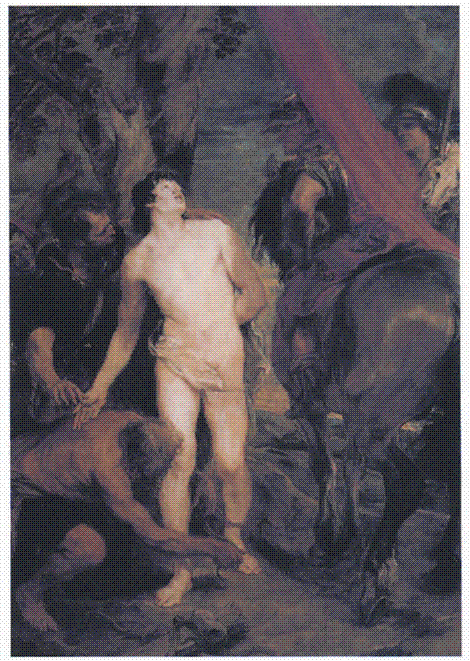
Anthony van Dyck, The Martyrdom of Saint Sebastian. c.1621. Canvas, 226 × 160 cm. National Gallery of Scotland, Edinburgh.
| |
| |
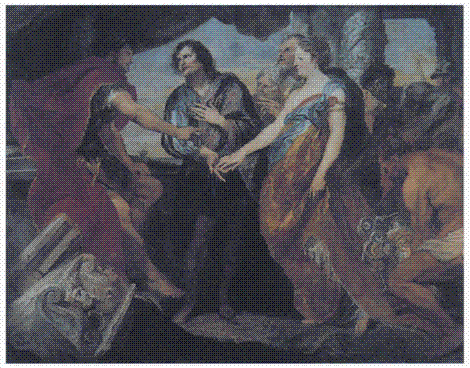
Anthony van Dyck, The Continence of Scipio. 1620-1621. Canvas, 183 × 232.5 cm. The Governing Body, Christ Church, Oxford.
It is hardly surprising that Rubens' gifted young assistant began to attract attention. Francesco Vercellini, the Venetian secretary of the great English collector the Earl of Arundel, wrote to his master from Antwerp in June 1620 that ‘Van Dyck is still with Signor Rubens and his works are hardly less esteemed than those of his master. He is a young man of twenty-one years, his father and mother very rich, living in this town, so that it will be difficult to get him to leave these parts, especially since he sees the good fortune that attends Rubens’. However, despite Vercellini's opinion, Van Dyck was tempted to England later that year and entered the service of King James i. He was in England for only a year but this was an important phase in his career in three respects. In the first place, he came to know England, where he was to settle twelve years later. Secondly, this was his first real experience of court life, and thirdly, and most importantly, he was able for the first time to study Venetian High Renaissance painting - particularly the work of Titian and Veronese - in the original in the houses of aristocratic collectors such as the Earl of Arundel and the Duke of Buckingham. Only three paintings can be ascribed to this formative year in England: a portrait of the Earl of Arundel (J. Paul Getty Museum, Los Angeles), the Continence of Scipio (Christ Church Picture Gallery, Oxford) and the portrait of the Duke and Duchess of Buckingham as Venus and Adonis (Private collection, London).
Van Dyck left London early in 1621 and spent the months from March until October in Antwerp. In the first days of October he left his native town for Italy, where he was to spend the next six years. He went first to Genoa, where he stayed with two friends from Antwerp, the brothers Cornelis and Lucas de Wael, both painters, engravers and art dealers who had settled in the wealthy maritime city and were prominent members of the large Flemish artistic community. Throughout his years in Italy Genoa, and in particular
| |
| |
the house of the De Wael brothers, was to be his base. During his first three years Van Dyck travelled extensively in the peninsula. He spent six months in Rome in 1622 and eight months there in the following year. He was in Venice in 1622 and in 1624 went to Sicily in order to paint the portrait of the Viceroy, Emmanuele Filiberto, Prince of Savoy (Dulwich Picture Gallery, London). In Palermo he received an important commission for an altarpiece for the Oratory of the Rosary and others for paintings of the city's patron, Saint Rosalie.
While in Italy, Van Dyck used a sketchbook which today is in the British Museum in London. It allows us to study the young Flemish painter's reactions to what he saw in Italy. The most remarkable feature of the Italian Sketchbook is the single-mindedness of Van Dyck. During his years in Italy, Rubens had been responsive to the wide range of visual experience - antique, Renaissance and post-Renaissance art - available to him. By contrast, the 22-year-old Van Dyck was already largely formed as an artist and knew what he was looking for in Italy; and what he was looking for was the work of the Venetian High Renaissance painters, and above all Titian. He made dozens of sketches of paintings by Titian which he saw in Rome, Venice and elsewhere. He also made painted copies after Titian.
After hurriedly leaving Palermo late in 1624 because of an outbreak of plague, Van Dyck returned to Genoa and, apart from a trip to southern France in the following year, spent most of the time from then until his return to Antwerp in the winter of 1627 in the city. During this time he was in constant demand as a portrait painter by the Genoese aristocracy. The elegance and richness of Van Dyck's portrait style was ideally suited to members of the wealthy oligarchy which controlled the Republic. In his portraits, members of the Pallavicini, Adorno, Grimaldi, Doria, Lomellini and other families are shown, often full-length, against an elaborate architectural backdrop, the richness of their dress set off by red draperies which cascade from the top right-hand corner of the paintings. To what was a formula established by Rubens during his Italian years, Van Dyck brought his gift for the depiction of lace, velvet and satin, and his ability to flatter his sitters by elongating their features and their hands to make them seem even more elegant and remote than they were in life.
Van Dyck arrived back in Antwerp shortly after the death of his sister Cornelia in September 1627. It may have been news of her illness which prompted his return. Van Dyck, like other members of his family, was of an intensely religious disposition. He was a devout, unwavering Catholic throughout his life. The death of his sister seems to have concentrated his mind on the condition of his soul and he drew up a will and joined the Confraternity of Bachelors, a lay brotherhood which had been formed in Antwerp under the direction of the Jesuits. In 1629 he painted the first of two great altarpieces for the Confraternity's Chapel in the Jesuit Church, the Virgin and Child with Saints Rosalie, Peter and Paul. In the following year he painted the Mystic Marriage of the Blessed Herman Joseph. These two great canvases, which today are both in the Kunsthistorisches Museum in Vienna, display a new maturity which is a consequence of Van Dyck's profound study of Venetian painting in Italy. The colours - the rose of the Virgin's robe, the gold and turquoise of the angel - are of a new refinement: they are the colours which Van Dyck had seen in Titian's Bacchanals and took over as his own.
| |
| |
| |
Iconography
Van Dyck returned from Italy with an established reputation. Shortly after his return he was appointed a court painter to the Archduchess Isabella and painted the first of a number of portraits of her. He was also in great demand as portraitist to members of Isabella's austere court in Brussels. Many members of the aristocracy of Flanders and Brabant - Arenbergs, De Lignes, De Croys, De Boisschots and Tassis - sat to him during the five hectic years between his return from Italy and his departure for England. There are also less formal portraits of friends and acquaintances like the artists Jan Snellincx, Paulus Pontius and Antonie van Opstal. Despite the hectic activity of these years, Van Dyck found time to travel. He made two trips to the United Provinces, where he worked for the Prince of Orange in The Hague. He made a number of portraits of Prince Frederick Henry and his wife, Amalia van Solms, and also painted for them two of his finest treatments of subjects from Italian literature, Amaryllis and Mirtillo from Guarini's Il Pastor Fido and Rinaldo and Armida from Tasso's Gerusalemme Liberata. Van Dyck
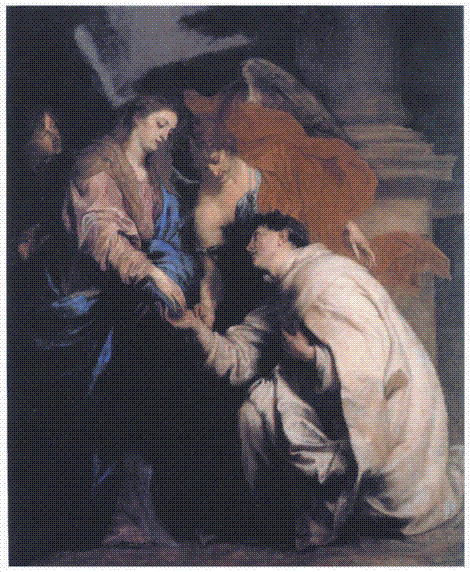
Anthony van Dyck, The Mystic Marriage of the Blessed Herman Joseph. 1629-1630. Canvas, 160 × 128 cm. Kunsthistorisches Museum, Vienna.
| |
| |
had little feeling for the classical world and it is unlikely that he read the Latin and Greek authors with real pleasure and understanding as Rubens did. His modern Italian was, however, fluent and Tasso, Ariosto and Guarini had created a world with which he felt great imaginative sympathy.
In the years between his return from Italy and his departure for London, Van Dyck's production of portraits was truly prodigious. His technical facility was absolute: for some of these portraits preparatory black chalk drawings survive, but rarely do they do more than study the pose, outlining the face and body. The portrait was created directly on the canvas. Van Dyck did not wish, however, to devote himself exclusively to portraiture, lucrative though it undoubtedly was. He wished to be recognised as a history painter, and Rubens' absence from Antwerp on diplomatic business in Spain and England in the years 1628-1630 gave him the opportunities he craved. Among the major commissions he received during those years were the Vision of Saint Augustine for the Augustijnerkerk in Antwerp and a series of paintings of the Crucifixion and the Lamentation. They are all characterised by intense religious emotionalism of a type closely identified with the Catholic revivalism of the Counter-Reformation and in particular with the Jesuit Order.
During these Antwerp years Van Dyck also began a project which was to occupy him until his death: a series of engraved portraits of famous men which was published after his death under the title of the Iconography. During Van Dyck's lifetime the portraits were published individually. Van Dyck made black chalk drawings after his own painted portraits, or after other portraits or from the life, and gave these to one of a number of trusted engravers, notably Paulus Pontius and Lucas Vorsterman. There are three principal groups of sitters: princes and military commanders, statesmen and philosophers, and artists and patrons. The last group is the most interesting, being the largest and containing many of Van Dyck's friends and acquaintances. It includes many sensitive and telling portraits and in its entirety provides a remarkable visual record of a whole generation of Flemish artists.
| |
Portraits of the King
Van Dyck moved to London early in 1632. Two years earlier Endymion Porter had purchased Rinaldo and Armida (Baltimore Museum of Art) for King Charles i and this large painting, in the tradition of Titian's poesie and suffused with the rich, saturated colour of Titian and Veronese, was immensely appealing to a royal collector whose passion was for the Venetians. Charles recognised in Van Dyck the heir to Titian and there is in Charles' patronage of Van Dyck a conscious echo of Emperor Charles v's patronage of Titian. Van Dyck was appointed ‘Principal Painter in Ordinary to Their Majesties’ on terms unparalleled in the history of British royal patronage. He was knighted in July 1632 and granted an annual pension of 200 pounds. He was also paid for each portrait painted of members of the Royal Family and in April 1633 was given a gold chain with a medallion of the King: he wears it in his Self-Portrait with a Sunflower (Collection of the Duke of Westminster). He was given a studio which was on the river at Blackfriars and had a special jetty from which the King could disembark when he came
| |
| |
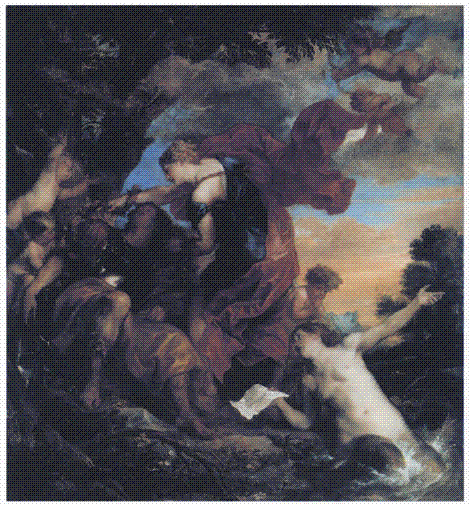
Anthony van Dyck, Rinaldo and Armida. 1629. Canvas, 236.5 × 224 cm. Baltimore Museum of Art (The Jacob Epstein Collection).
to visit the painter. He was also given an apartment at Eltham Palace for the summer months.
Although Charles i and his French Queen, Henrietta Maria, were painted by many artists, it is in Van Dyck's portraits that they are remembered today. He fixed their images and those of the members of the doomed Caroline court for posterity. The accounts of the Royal Household reveal that the King and Queen constantly commissioned portraits from Van Dyck. In 1632 he painted them in the portrait which is known from the Royal Inventory as ‘the Greate Peece’ (Royal Collection, London). They are shown seated with Prince Charles at his father's knee and the baby Princess Mary in her mother's arms. The portrait hung at the end of the Long Gallery at Whitehall Palace. A second royal portrait, painted in the following year, was destined for a similar position - to fill a whole wall at the end of a long gallery at St James's Palace. It shows the King on horseback riding through a triumphal arch, accompanied on foot by his riding master, Monsieur de St Antoine.
| |
| |
This painting and the equestrian portrait now in the National Gallery, London, are among the greatest achievements of equestrian portraiture. Both are exercises in royal propaganda, conscious idealisations of the monarch which evoke memories of the famous statue of Emperor Marcus Aurelius on the Capitol at Rome and Titian's portrait of Emperor Charles V at the Battle of Muhlberg. In the Roi à la Chasse in the Louvre the King's demeanour is quite different. Standing, his horse held by a groom, he wears a wide-brimmed black hat, a leather doublet and high boots. Elegant and relaxed, he surveys the countryside and the distant sea. Of all Van Dyck's portraits of the King this is the most beautiful, with its rich colours, daring composition and assured technique. Van Dyck painted many portraits of Henrietta Maria, softening her long nose and prominent jaw by carefully choosing the most flattering angle for her head. He emphasised the delicacy of her complexion, her face framed in brown curls.
Van Dyck spent most of 1634 and 1635 back in Flanders, where he painted a number of important sitters including the Marquis of Leganes, John of Nassau-Siegen and his family and the Abbé Scaglia, as well as undertaking
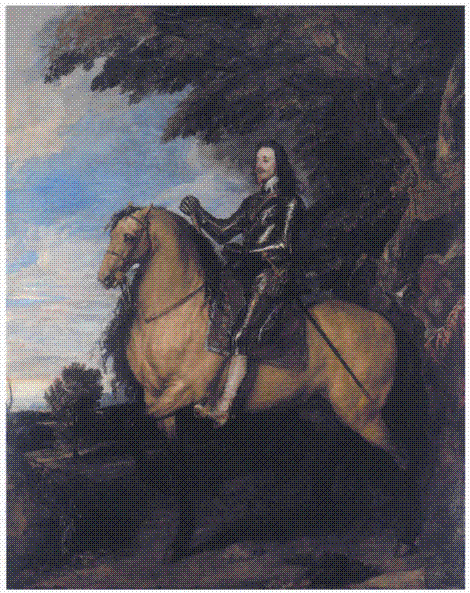
Anthony van Dyck, Equestrian Portrait of Charles I. c.1632. Canvas. National Gallery, London.
| |
| |
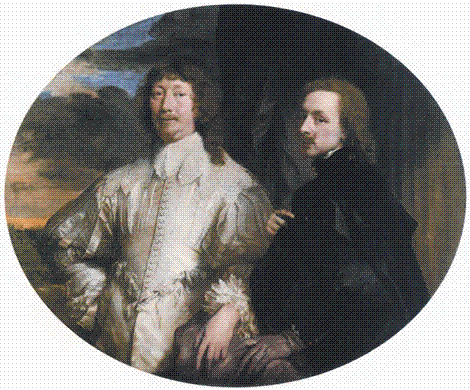
Anthony van Dyck, Sir Endymion Porter and Anthony van Dyck. 1630s. Canvas, oval. Prado, Madrid.
a major commission of a portrait group of the échevins for the Town Hall in Brussels. Just after his return to England, Van Dyck painted a group portrait of the three royal children, which was sent by Henrietta Maria to her sister, the Duchess of Savoy, and today is still in Turin, in the Galleria Sabauda. It is a masterpiece of child portraiture, each face, even that of the baby Prince James, being sharply characterised. The faces are caught in a moment of repose but there is nothing solemn about them: all three seem quite capable of mischief.
The Royal Family's patronage of Van Dyck was not limited to portraits. Charles already owned the Rinaldo and Armida and at the end of the 1630s Van Dyck painted for him the exquisite Cupid and Psyche, which is still in the Royal Collection. Here, even more than in any of his portraits, Van Dyck is the heir of Titian. The sensuous nudes, the delicate combination of blues, greens and pinks, the textures of silk, flesh, feather and foliage, and the balanced composition all combine to make this painting one of Van Dyck's greatest pictures.
Where the Royal Family led, the court naturally followed; and our image of the sophisticated court of Charles i is that created by Van Dyck. Among the many outstanding portraits of members of the court are the double portraits of George Digby, 2nd Earl of Bristol, and William Russell, 1st Duke of Bedford (Collection of the Earl Spencer, Althorp House) and Lords John
| |
| |

Anthony van Dyck, Lords John and Bernard Stuart. 1630s. Canvas. National Gallery, London.
and Bernard Stuart, who were both to die fighting for the King in the Civil War, in the National Gallery, London. One of Van Dyck's principal patrons in England was the 4th Earl of Pembroke, for whom he painted his largest single work, the great Family Portrait which hangs in the Double Cube Room at Pembroke's seat, Wilton House near Salisbury. Another leading member of Charles' court who was a regular patron of Van Dyck was the 10th Earl of Northumberland, who is shown in two fine portraits at Alnwick Castle with his baton of Lord High Admiral. Among the many other patrons of Van Dyck during his English years were Philip, 4th Lord Wharton, who built a special gallery at Winchendon House, near Aylesbury, to accommo- | |
| |
date the series of family portraits commissioned from Van Dyck; Thomas Wentworth, Earl of Strafford, one of the King's principal advisers in the years leading up to the outbreak of the Civil War; the Earl of Arundel, his earliest English patron, who did not occupy the key position at Charles 1's court that he did at his father's but as premier Earl commanded the royal army against the Scots in 1639 and is shown by Van Dyck in armour; the poet Thomas Killigrew; and the dramatist Sir John Suckling.
In England Van Dyck never received the great decorative commissions for which he hankered: a series of tapestries to hang in the Banqueting House in Whitehall was planned but got no further than an oil sketch. Frustrated by this lack of opportunity and with the political situation in England deteriorating, Van Dyck often visited Flanders and when Rubens died in May 1640 he was invited to Antwerp to supervise his workshop. Philip iv of Spain was anxious to receive four large-scale history paintings left unfinished at Rubens' death. Van Dyck refused to complete another painter's work but did agree to paint a new picture of the same subject. Back in London and beginning to make arrangements to move back to Antwerp, Van Dyck heard that the King of France was about to award the commission for the decoration of the principal galleries of the Louvre. This was the large-scale project for which he had been waiting and for which he considered himself uniquely well-suited. He went to Paris in January 1641 but was back in London in May when he painted the double portrait of Princess Mary and Prince William of Orange on the occasion of their marriage (Rijksmuseum, Amsterdam). He was in Antwerp again in October and in Paris in November, when he received the disappointing news that the Louvre commission had gone to Nicolas Poussin and Simon Vouet. Throughout these months of intensive work and travel, contemporaries remarked on the painter's poor health and on his return to London from Paris it gave cause for alarm. The King sent his own physician, offering him 300 pounds if he could restore the painter to health. On 1 December Lady Van Dyck, Mary Ruthven, one of the Queen's ladies-in-waiting whom the painter had married in 1639, gave birth to a daughter, Justiniana. Three days later Van Dyck made his last will and five days after that, on 9 December 1641, he died, at the age of 42.
Van Dyck's influence on painting not only in England but also in Italy and the Low Countries was profound and long-lasting. He transformed portrait painting in the three cities in which he worked. In Genoa his style was imitated by a whole generation of native painters. In Antwerp his manner was taken up not only by the local portraitists but throughout the Netherlands. In Amsterdam, for example, the fashionable portraits of Bartholomeus van der Helst and Govert Flinck reveal a profound debt to Van Dyck in scale, technique and composition. In England the revolution in portrait painting from medieval icon to modern portrait, begun by his Low Countries predecessors at the English court, was brought to a triumphant conclusion by Van Dyck.
christopher brown
Christopher Brown is the organiser of the exhibition of Anthony van Dyck's paintings which is to be held at the Koninklijk Museum voor Schone Kunsten, Antwerp and the Royal Academy of Arts, London, in 1999.
| |
Further reading
| brown, christopher, Van Dyck. Oxford, 1982. |
| brown, christopher, The Drawings of Anthony van Dyck. New York, 1991. |
| larsen, erik, The Paintings of Anthony van Dyck (2 vols.). Freren, 1988. |
|
|